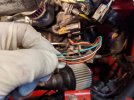I have been working my way through upgrading the lighting on my 85X. This past week I installed LEDs in the tail lights, front and rear turn signals and reverse lights. I put the proper LED flasher in the relay tray. Somehow, I forgot to order the marker LEDs and license plate LEDs. I will get the markers, but I think I may leave the license bulbs stock. The recommended LED didn't fit very well in the housing.
Today, I finally got around to installing the
headlight relay kit I got off Amazon for about $20.00USD. I decided to try the Amazon set, since I had used a similar Ebay set on the 124 Special a few years ago. The kit is not as well made as Bob's kits, and some wires needed to be extended or have their terminators snipped and swapped for something more appropriate.
Anywho... It took me a few hours to work thru the process. I put the relays in the passenger side pod, because there were easily accessible wire grommets to use for routing the power wire to the battery. I ran a 10ga wire from the battery into the pod and attached it to the kit's power wire that had a 30a fuse holder installed. My 85 had two little dimples stamped in the pod ahead of the position where the ground blossom is installed. I drilled the forwardmost dimple and bolted the relay set inside the pod.
View attachment 47454 View attachment 47455
There was plenty of wire between the two head light connectors to reach between the headlight pods. I did have to remove the kit's headlight connector for the "remote" headlight in order to get the wires thru the grommets in the pods. I zip tied the headlight wires to the stock loom that passes between the pods. Horrible picture, I should have taken a picture when the car was in the air. The thicker and cleaner blue and white wires towards the top of the picture are the high/low beam wires running from the relay set to the driver side headlight.
View attachment 47457
The biggest concern I had was the headlight connectors themselves. The X has 90 degree wire connectors to provide a little wiggle room. The kit's connectors are not 90s and I was a little worried that I wouldn't be able to get them on without pulling the headlights. I managed to carefully get them on, but then I was worried the wires would rub on the headlight bucket or the pod's cross support in operation. Thankfully it all worked out and none of the wires is rubbing. You can see there is some clearance between the bucket and the wires on the connector. I will probably go back through and see if there are places that might benefit from another zip tie or two for wire management.
Driver side:
View attachment 47453 Passenger side:
View attachment 47458
Prior to all this light upgrading, my volt meter would drop significantly when the headlights were on, or brakes were applied. It would swing up and down with the blinkers. If it rained, I just left the wipers off. Try any combination of the above and the volt meter would bottom out. I took a test drive this evening after finishing up and now the voltmeter barely moves no matter which lights I turn on. I am sure the blinkers would still make the VM unhappy, but that is a task for another time.
As I was leaving the garage, I noticed there are lots of open hoods and engine covers. Lots of little tasks to take care of on each car.
View attachment 47460

